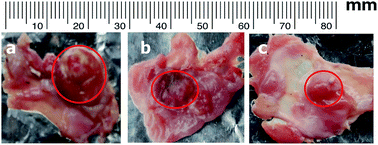Endogenous porphyrin fluorescence as a biomarker for monitoring the anti-angiogenic effect in antitumor response to hesperetin loaded nanoparticles in experimental oral carcinogenesis
Abstract
The purpose of the present study is to evaluate the antitumor efficacy of hesperetin loaded nanoparticles (HETNPs) in comparison with native hesperetin (HET) for monitoring endogenous porphyrin emission against 7,12-dimethyl benz[a]anthracene (DMBA)-induced hamster buccal pouch carcinogenesis. The effort has been further complemented by immunohistochemical analysis in an attempt to provide a correlation between the emission intensity of endogenous porphyrin and changes in the vascular endothelial growth factor (VEGF) expression observed in control and the experimental animals. A total of 60 autofluorescence spectra were successfully acquired from different anatomic locations of the control and the experimental tissues. Significant differences in the autofluorescence spectral signatures between the control and that of experimental animals have been noticed under the excitation wavelength of 410 nm with emission ranging from 440–750 nm. DMBA-induced tumor tissues are associated with increased endogenous porphyrin emissions at ∼630 nm, ∼670 nm and ∼705 nm. Moreover, oral administration of HET and its nanoparticulates restored the status of endogenous porphyrin emission in the buccal mucosa of DMBA-painted animals. On a comparative basis, the treatment of nanoparticulate hesperetin was found to be more effective than native hesperetin in reducing the formation of squamous cell carcinoma and in improving the status of endogenous porphyrins to a near normal range in DMBA-induced hamster buccal pouch carcinogenesis. These endogenous porphyrin emissions may be used as a spectral biomarker for monitoring tumor hypervascularity. The hypervascularity in tumors might be due to angiogenesis. Complementary immunohistochemical analysis of the DMBA-induced tumor tissues showed an abundant expression of VEGF (a marker used for angiogenesis), suggesting that increased endogenous porphyrin intensities may be correlated with angiogenesis. Furthermore, the spectral data are also analyzed using a multivariate data analysis and yielded diagnostic sensitivities of 100%, 76.0%, 93.0% and 80.0% and specificities of 100%, 73.3%, 86.0% and 86.6%, respectively, for classification of control vs. DMBA, DMBA vs. DMBA + HET, DMBA vs. DMBA + HETNPs and DMBA + HET vs. DMBA + HETNPs treated tissues. The present study further suggests that endogenous porphyrin fluorescence could be considered as a reliable spectral marker and a very useful tool for monitoring the anti-angiogenic effect of cancer.


 Please wait while we load your content...
Please wait while we load your content...